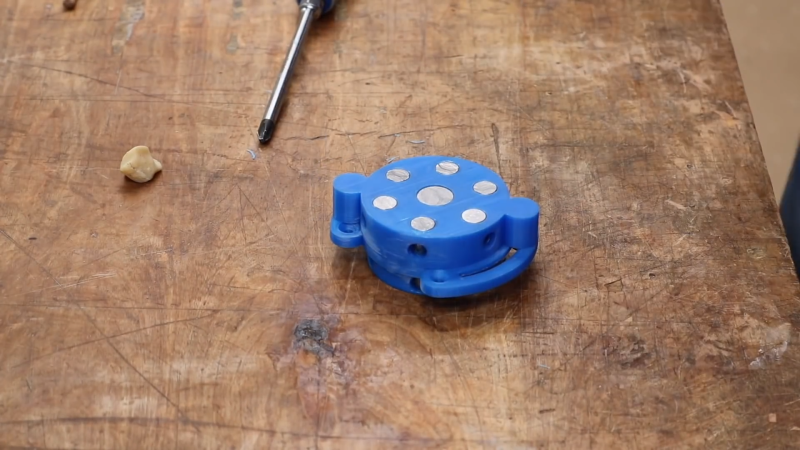Permanent magnets aren’t typically switchable. They’re always doing their magnet thing. However, if you align them with a bunch of other magnets in just the right way, you can create a permanent magnet that you can effectively switch on and off. [Andrew Klein] has done just that with his 3D-printed magnetic switch design.
The concept is simple enough. The design consists of a 3D-printed housing in two parts, top and bottom. When set into one orientation, the housing holds two arrays of magnets in opposite orientations. This effectively cancels out their magnetic fields and allows you to move the assembly around as if it’s pretty much not magnetic at all. However, rotate the device to its alternative orientation, and the magnets poles are aligned. This effectively combines their magnetic fields and makes the assembly act as one big large magnet.
These devices are useful if you want to create magnetic clamps or fixtures that can be attached and detached at will from ferrous surfaces. Being able to effectively “switch the magnet off” is much easier than trying to wrench a powerful magnet from a metal plate, after all.
You can do something similar with electromagnetic techniques, too! Video after the break.















I would call those switchable magnets, to distinguish them from switches controlled by magnets. Your mileage may vary.
haha yeah i was thinking about the time i put a magnet in a little 3d printed linear friction slider, and used it to turn a light on and off using a reed switch.
a switched magnet is way more esoteric. not sure what it’s for but kind of a hack!
Here’s another variant, where you can download the STL’s for free:
https://www.thingiverse.com/thing:4017529
He starts with “Baltic birch is pretty expensive, I have not done the math but I thing 3D printing is cheaper”. Duh. The disks look like they have a diameter of around 80mm. That means you can get 450 out of a big sheet of baltic birch, which costs around USD100. So if this contraption needs 4 of those disks, then the cost of the wood is still less then the 3D printed version which he estimates at USD 1.5. And also, they are very small pieces and you often have some leftovers from other projects. But the magnets themselves are going to be the biggest cost.
I do agree with the time part though. Making those nice round disks out of a big sheet costs a lot of time unless you have a CNC machine that does it for you (and even then setup time is a bummer). Working on a CNC machine with small pieces of leftovers is also a nuisance, but if you have a big CNC job, you can just nest these disks in, and both setup time and costs are minimal.
For the rest. I really do not like this design. With the magnets sticking to the sides of the round rods you have a very small contact area, and this significantly reduces the effective force of the magnets.
You’re assuming enough are needed to consume a full sheet. Doing so and putting the magnets into them is quite a costly endeavor, so unlikely. If the project is to make a half dozen, additive is much less costly. Also, even 12 x 12 or 12 x 24 BB panel from a hobby store has a large markup.
3D printed magnetic charger pls
https://magswitch.com/
The small ones are available from Uncle Bezos. They used in woodworking if you have a cast iron table.
Nice MagSwitch shoutout. Their products are excellent. But the PRICE for using their magnets to make my own jigs is itself the very reason my attention locked onto this article.
I don’t mind the featuring video is from five years ago as the content is still relevant. The video explains the function very well, and helps the readers to make their own variation on the concept. I do have a bit of an issue with the monetization.
The current model of showing off a design, and then selling (access to) the design doesn’t work for me. While I believe there is no obligation to share knowledge or the design for free, the expectation that STL are available are usually there. I don’t mind supporting the creators. Even more so when the file is cheaper than the material costs, and the total price is a better deal than purchasing the mass production item.
My problem lies first with that I’m following several creators, and can’t support all of them on Patreon. Even more so when support is no longer $1, but starts at $5 a month, with some premium files locked to higher tiers of support. While you can join for a single month, I don’t believe this is a healthy way to show support for creators. It could also incentivize the creators to restrict access to files even further, for example by making the files available for a short time only.
This particular file doesn’t look too complicated, and in redesigning one would likely use metric hardware. But these inspired works are rarely shared online due to copyright and ethical concerns. This has the effect to further prevent progress, as there won’t be a free version which the community can iterate over and make better in the process.